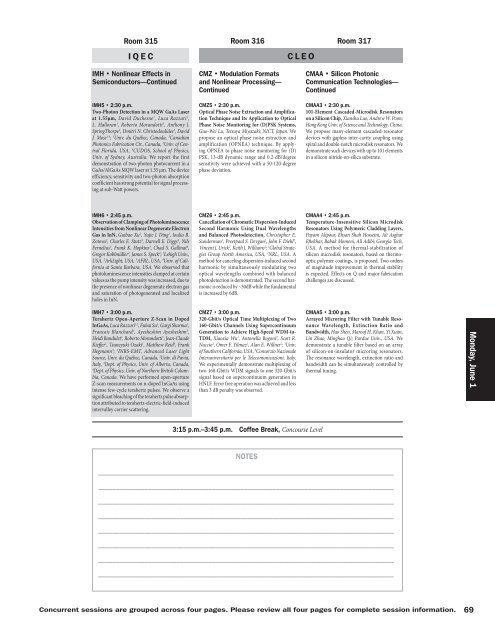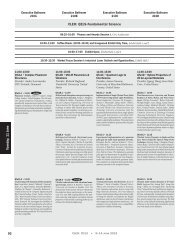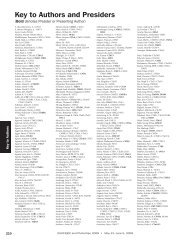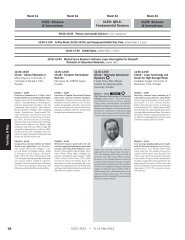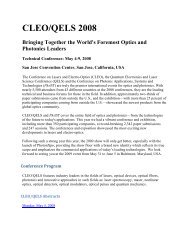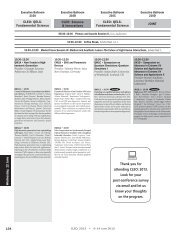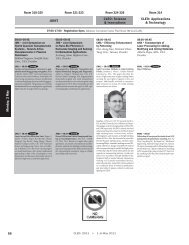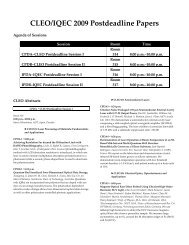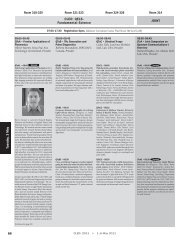Room 315 Room 316 Room 317IQEC<strong>CLEO</strong>IMH • Nonlinear Effects inSemiconductors—ContinuedCMZ • Modulation Formatsand Nonlinear Processing—ContinuedCMAA • Silicon PhotonicCommunication Technologies—ContinuedIMH5 • 2:30 p.m.Two-Photon Detection in a MQW GaAs Laserat 1.55μm, David Duchesne 1 , Luca Razzari 1 ,L. Halloran 1 , Roberto Morandotti 1 , Anthony J.SpringThorpe 2 , Dmitri N. Christodoulides 3 , DavidJ. Moss 1,4 ; 1 Univ. du Québec, Canada, 2 CanadianPhotonics Fabrication Ctr., Canada, 3 Univ. of CentralFlorida, USA, 4 CUDOS, School of Physics,Univ. of Sydney, Australia. We report the firstdemonstration of two-photon photocurrent in aGaAs/AlGaAs MQW laser at 1.55 μm. The deviceefficiency, sensitivity and two-photon absorptioncoefficient has strong potential for signal processingat sub-Watt powers.CMZ5 • 2:30 p.m.Optical Phase Noise Extraction and AmplificationTechnique and Its Application to OpticalPhase Noise Monitoring for (D)PSK Systems,Guo-Wei Lu, Tetsuya Miyazaki; NICT, Japan. Wepropose an optical phase noise extraction andamplification (OPNEA) technique. By applyingOPNEA to phase noise monitoring for (D)PSK, 13-dB dynamic range and 0.2-dB/degreesensitivity were achieved with a 50-120-degreephase deviation.CMAA3 • 2:30 p.m.101-Element Cascaded-Microdisk Resonatorson a Silicon Chip, Xianshu Luo, Andrew W. Poon;Hong Kong Univ. of Science and Technology, China.We propose many-element cascaded-resonatordevices with gapless inter-cavity coupling usingspiral and double-notch microdisk resonators. Wedemonstrate such devices with up to 101 elementsin a silicon nitride-on-silica substrate.IMH6 • 2:45 p.m.Observation of Clamping of PhotoluminescenceIntensities from Nonlinear Degenerate ElectronGas in InN, Guibao Xu 1 , Yujie J. Ding 1 , Ioulia B.Zotova 2 , Charles E. Stutz 3 , Darnell E. Diggs 3 , NilsFernelius 3 , Frank K. Hopkins 3 , Chad S. Gallinat 4 ,Gregor Koblmüller 4 , James S. Speck 4 ; 1 Lehigh Univ.,USA, 2 ArkLight, USA, 3 AFRL, USA, 4 Univ. of Californiaat Santa Barbara, USA. We observed thatphotoluminescence intensities clamped at certainvalues as the pump intensity was increased, due tothe presence of nonlinear degenerate electron gasand saturation of photogenerated and localizedholes in InN.CMZ6 • 2:45 p.m.Cancellation of Chromatic Dispersion-InducedSecond Harmonic Using Dual Wavelengthsand Balanced Photodetection, Christopher E.Sunderman 1 , Preetpaul S. Devgan 2 , John F. Diehl 2 ,Vincent J. Urick 2 , Keith J. Williams 2 ; 1 Global StrategiesGroup North America, USA, 2 NRL, USA. Amethod for canceling dispersion-induced secondharmonic by simultaneously modulating twooptical wavelengths combined with balancedphotodetection is demonstrated. The second harmonicis reduced by ~30dB while the fundamentalis increased by 6dB.CMAA4 • 2:45 p.m.Temperature-Insensitive Silicon MicrodiskResonators Using Polymeric Cladding Layers,Payam Alipour, Ehsan Shah Hosseini, Ali AsgharEftekhar, Babak Momeni, Ali Adibi; Georgia Tech,USA. A method for thermal-stabilization ofsilicon microdisk resonators, based on thermoopticpolymer coatings, is proposed. Two ordersof magnitude improvement in thermal stabilityis expected. Effects on Q and major fabricationchallenges are discussed.IMH7 • 3:00 p.m.Terahertz Open-Aperture Z-Scan in DopedInGaAs, Luca Razzari 1,2 , Fuhai Su 3 , Gargi Sharma 1 ,Francois Blanchard 1 , Ayesheshim Ayesheshim 3 ,Heidi Bandulet 1 , Roberto Morandotti 1 , Jean-ClaudeKieffer 1 , Tsuneyuki Ozaki 1 , Matthew Reid 4 , FrankHegmann 3 ; 1 INRS-EMT, Advanced Laser LightSource, Univ. du Québec, Canada, 2 Univ. di Pavia,Italy, 3 Dept. of Physics, Univ. of Alberta, Canada,4Dept. of Physics, Univ. of Northern British Columbia,Canada. We have performed open-apertureZ-scan measurements on n-doped InGaAs usingintense few-cycle terahertz pulses. We observe asignificant bleaching of the terahertz pulse absorptionattributed to terahertz-electric-field-inducedintervalley carrier scattering.CMZ7 • 3:00 p.m.320-Gbit/s Optical Time Multiplexing of Two160-Gbit/s Channels Using SupercontinuumGeneration to Achieve High-Speed WDM-to-TDM, Xiaoxia Wu 1 , Antonella Bogoni 2 , Scott R.Nuccio 1 , Omer F. Yilmaz 1 , Alan E. Willner 1 ; 1 Univ.of Southern California, USA, 2 Consorzio NazionaleInteruniversitario per le Telecomunicazioni, Italy.We experimentally demonstrate multiplexing oftwo 160-Gbit/s WDM signals to one 320-Gbit/ssignal based on supercontinuum generation inHNLF. Error free operation was achieved and lessthan 3 dB penalty was observed.CMAA5 • 3:00 p.m.Arrayed Microring Filter with Tunable ResonanceWavelength, Extinction Ratio andBandwidth, Hao Shen, Maroof H. Khan, Yi Xuan,Lin Zhao, Minghao Qi; Purdue Univ., USA. Wedemonstrate a tunable filter based on an arrayof silicon-on-insulator microring resonators.The resonance wavelength, extinction ratio andbandwidth can be simultaneously controlled bythermal tuning.<strong>Monday</strong>, <strong>June</strong> 13:15 p.m.–3:45 p.m. Coffee Break, Concourse LevelNOTES________________________________________________________________________________________________________________________________________________________________________________________________________________________________________________________________________________________________________________________________________________________________________________________________________________________________________________________________________________________________________________________________________________________________________________________________________________________________________________________________________________________Concurrent sessions are grouped across four pages. Please review all four pages for complete session information.69
Room 336 Room 337 Room 338 Room 339<strong>CLEO</strong>CMBB • Laser Sources—ContinuedCMCC • Endoscopic ImagingApplications—ContinuedCMDD • Spectroscopic GasSensing I—ContinuedCMEE • Ultraviolet and BlueLight Emitters—ContinuedCMBB5 • 2:30 p.m.Nonlinear Absorption and Carrier Dynamics inSlab-Coupled Optical Waveguide Amplifiers, AliR. Motamedi 1 , Erich P. Ippen 1 , Jason J. Plant 2 , JosephP. Donnelly 2 , Paul W. Juodawlkis 2 ; 1 MIT, USA, 2 MITLincoln Lab, USA. Loss due to the two-photonabsorption and free-carrier absorption processesbecomes a dominant factor for ultrashort-pulseamplification, leading to lower saturation energy.TPA and FCA coefficients are measured to be65cm/GW and 7x10 -17 cm 2 , respectively.CMCC5 • 2:30 p.m.Microfabricated out-of-Plane Scanning Microlensfor Raman Spectroscopy, Chin Pang BillySiu 1 , Haishan Zeng 2 , Mu Chiao 1 ; 1 Univ. of BritishColumbia, Canada, 2 British Columbia CancerRes. Ctr., Canada. We present a microfabricatedout-of-plane scanning microlens for miniaturizedRaman Spectroscopy. The out-of-plane actuationis electrostatic driven and achieves 90 μm scanrangeat 1k Hz. A Raman spectrum analysis onthe drug, Tylenol, is reported.CMDD4 • 2:30 p.m.Compact Gas Sensing System Based on Mid-Infrared LED and Resonant Detection withQuartz Tuning Fork, Ulrike Willer, Claus Romano,Wolfgang Schade; Clausthal Univ. of Technology,Germany. A Winston cone, used simultaneouslyas absorption cell, concentrates the radiation of amid-infrared LED onto a prong of a quartz tuningfork acting as detector, providing a compact andcost efficient mid-infrared sensing system.CMEE4 • 2:30 p.m.The Effects of Increasing AlN Mole Fraction onthe Performance of AlGaN Based UltravioletLight Emitting Diode Active Regions, AnandV. Sampath 1 , Gregory A. Garrett 1 , Wendy L.Sarney 1 , H. Shen 1 , Michael Wraback 1 , James R.Grandusky 2 , Leo J. Showalter 2 ; 1 ARL, USA, 2 CrystalIS, USA. Time-resolved photoluminescence andtransmission electron microscopy results suggestthat the density of point defects may have a moresignificant role than threading dislocations in theperformance of UVLED AlGaN active regionsemitting at shorter wavelengths.CMBB6 • 2:45 p.m.Mode-Locking via Active Gain Modulation inQuantum Cascade Lasers, Lyuba Kuznetsova 1 , C.Y. Wang 1 , V. M. Gkortsas 2 , L. Diehl 1 , F. Kärtner 2 ,M. A. Belkin 3 , A. Belyanin 4 , X. Li 1 , D. Ham 1 , H.Schneider 5 , H. C. Liu 6 , Federico Capasso 1 ; 1 HarvardUniv., USA, 2 MIT, USA, 3 Univ. of Texas at Austin,USA, 4 Texas A&M Univ., USA, 5 Inst. of Ion BeamPhysics and Materials Res., Germany, 6 Natl. Res.Council, Canada. A mode-locking mechanismby active gain modulation is studied numericallyand experimentally. The parameter window for theemission of stable pulse trains was found. Pulsesas short as 3ps (~0.5pJ) were characterized bysecond-order autocorrelation.CMCC6 • 2:45 p.m.Fiber-Optic Endomicroscopy for Intrinsic Two-Photon Fluorescence Imaging of Epithelial Cellsand Tissues, Yicong Wu 1 , Jiefeng Xi 1 , YongpingChen 1 , Michael J. Cobb 1 , Ming-Jun Li 2 , Xingde Li 1 ;1Dept. of Bioengineering, Univ. of Washington,USA, 2 Science and Technology Div., CorningInc., USA. An endomicroscope with enhancedsignal collection efficiency was developed usingcustomized double-clad fiber and asphericalcompound-lens. Ex vivo two-photon fluorescenceimaging of epithelial tissues was demonstratedfor the first time with an all-fiber-optic scanningendomicroscope.CMDD5 • 2:45 p.m.Location-Resolved Gas Concentration DetectionUsing Frequency-Shifted Interferometry,Fei Ye, Li Qian, Bing Qi; Univ. of Toronto, Canada.We use frequency-shifted interferometry to detectthe concentrations of the same gas species at differentlocations and in different mixtures by accuratelycorrecting the spectral shadowing effect.Different gas species are also detected.CMEE5 • 2:45 p.m.1-D Carrier Localization and Effective QuantumWire Behavior inside “Wrinkled” QWs Depositedon Textured GaN, Spilios Riyopoulos 1 , TheodoreMoustakas 2 ; 1 SAIC, USA, 2 Boston Univ., USA.Ridges among intersecting quantum wells depositedon textured GaN behave as 1-D quantum wiresdue to geometry and polarization effects. Carrierlocalization, carrier accumulation and emissionblue shifting are derived theoretically.<strong>Monday</strong>, <strong>June</strong> 1CMBB7 • 3:00 p.m.Coherent Dynamics of One- and Two-PhotonStates in a Strongly Coupled Single QuantumDot-Cavity System, Jacek Kasprzak 1 , WolfgangLangbein 1 , S. Reitzenstein 2 , C. Kistner 2 , C. Schneider2 , M. Strauss 2 , S. Höfling 2 , A. Forchel 2 ; 1 CardiffUniv., UK, 2 Technische Physik, Univ. Würzburg,Germany. Heterodyne spectral interferometry isemployed to perform four-wave mixing spectroscopyon a strongly-coupled system of an excitonconfined in a single quantum dot and a photonmode of a pillar microcavtity.CMCC7 • 3:00 p.m.Handheld Single-Cell-Layer Optical SectioningReflectance Confocal Microscope forInterventional Imaging, Karthik Kumar 1 , RonyAvritscher 2 , David C. Madoff 2 , Xiaojing Zhang 1 ;1Univ. of Texas at Austin, USA, 2 M. D. AndersonCancer Ctr., Univ. of Texas, USA. We introduce ahandheld reflectance confocal microscope providing4.2μm axial, 0.5μm lateral resolution, and200x125μm field based on novel CMOS-MEMS2-axis scanning micromirrors. Examination of exvivo swine liver indicates applicability to clinicalimage-directed intervention.CMDD6 • 3:00 p.m.Fourier Transform Spectrometry with a NearInfrared Supercontinuum Source, Chris A.Michaels, Tony Masiello, Pamela M. Chu; NIST,USA. Near-infrared Fourier transform absorptionspectrometry with a supercontinuum (SC) sourceis demonstrated for trace methane detection. TheSC source allows for long distance propagationwhile exhibiting amplitude noise ten times greaterthan comparable incandescent sources.CMEE6 • 3:00 p.m.Towards Room Temperature ElectricallyPumped Blue Vertical Cavity Surface EmittingLasers, Gatien Cosendey, Eric Feltin, AntoninoCastiglia, Jean-François Carlin, Alexei Altoukhov,Jacques Levrat, Gabriel Christmann, Raphael Butté,Nicolas Grandjean; École Polytechnique Fédéralede Lausanne, Switzerland. We report strategiesto achieve lasing in electrically driven VCSELs at300K, namely high quality microcavity suited forelectrical injection, use of a ZnO contact with acurrent confinement layer, and oxidized AlInN/GaN Bragg reflectors.3:15 p.m.–3:45 p.m. Coffee Break, Concourse LevelNOTES________________________________________________________________________________________________________________________________________________________________________________________________________________________________________________________________________________________________________________________________________________________________________________________________________________________________________________________________________________________________________________________________________________________________________________________________________________________________________________________________________________________________________________________________________________________________________________________________________________________________________________________________________________________________________________________________________70<strong>CLEO</strong>/IQEC and PhotonXpo <strong>2009</strong> • May 31–<strong>June</strong> 5, <strong>2009</strong>


